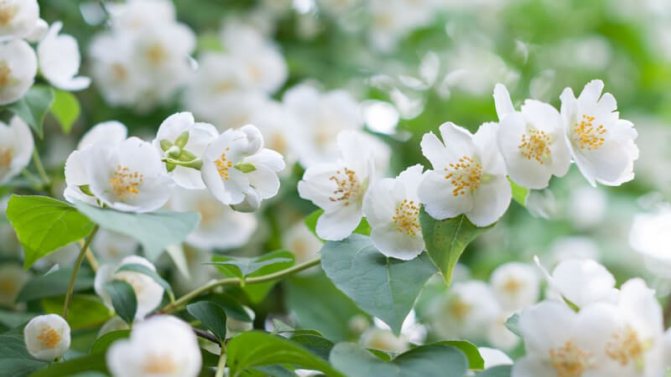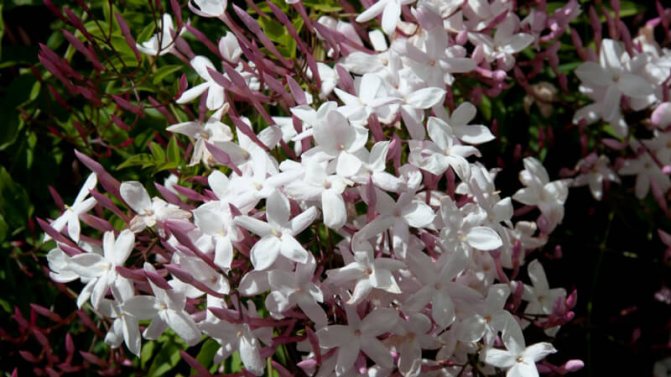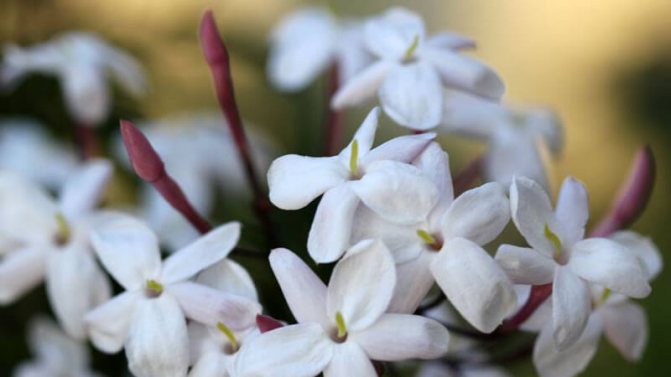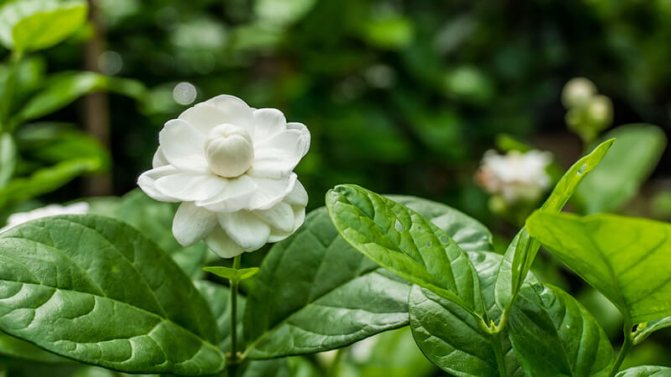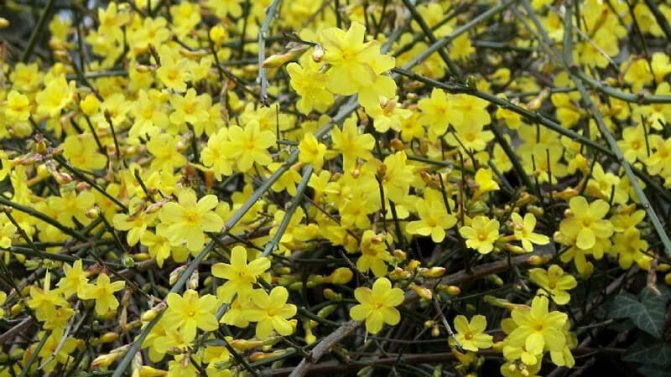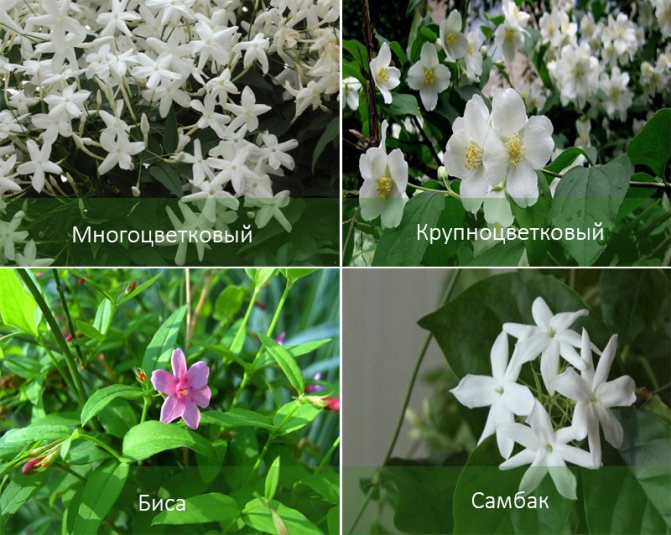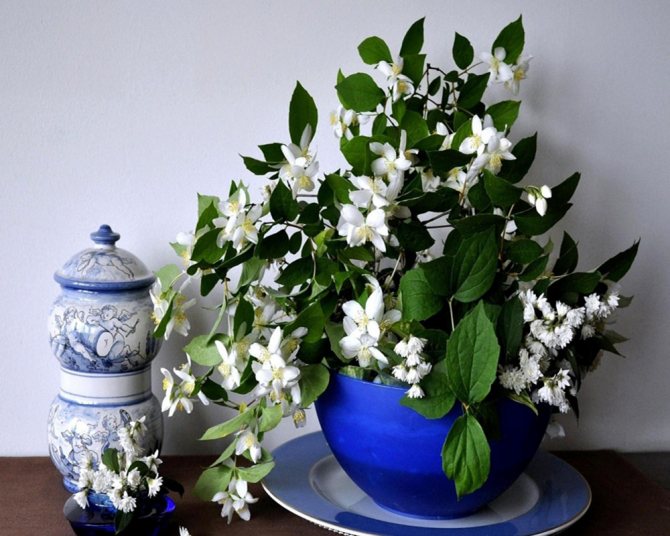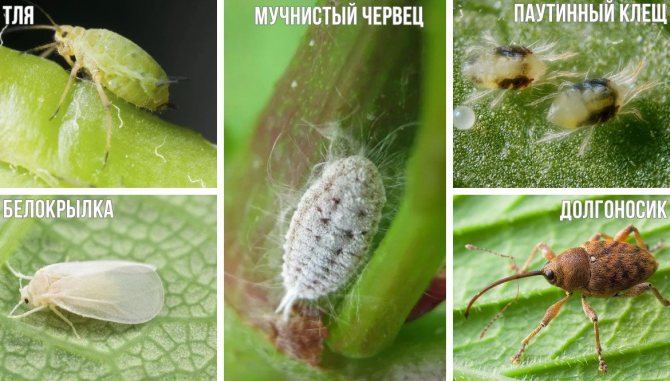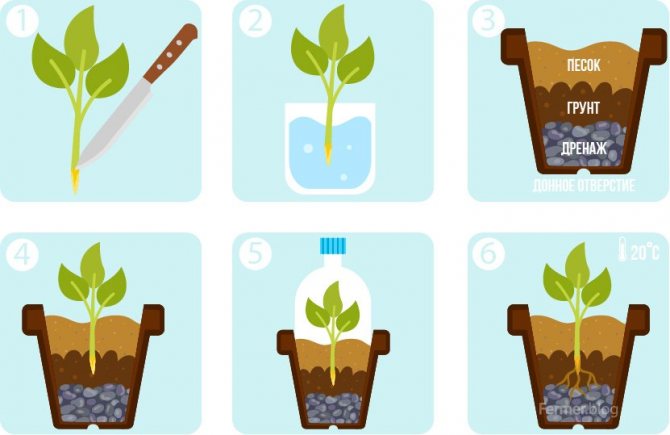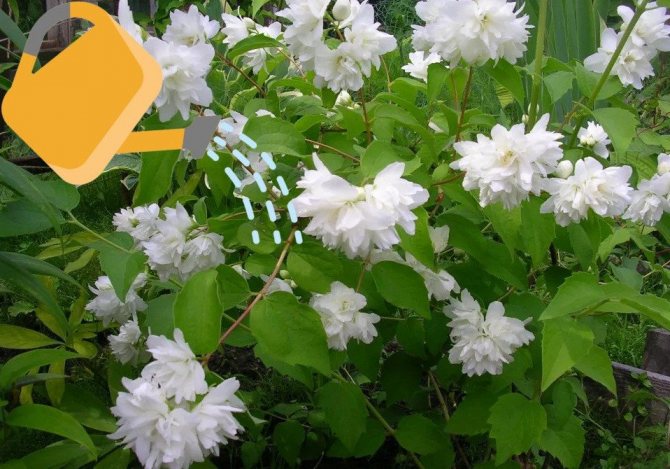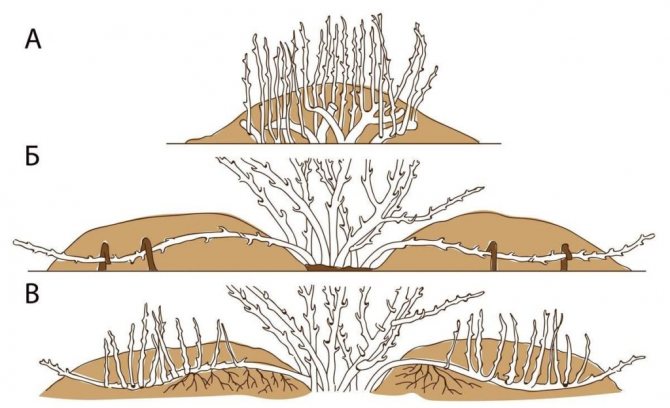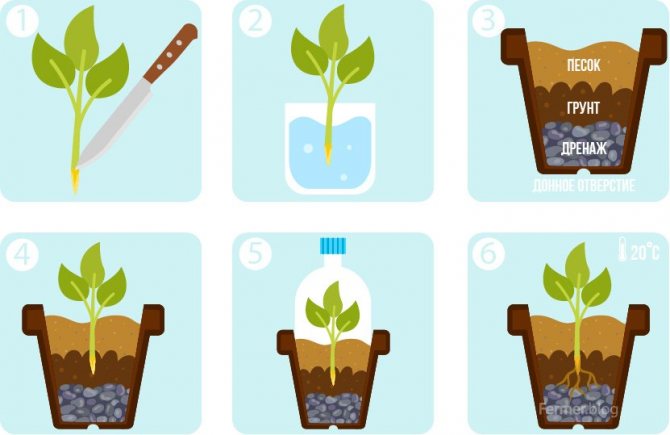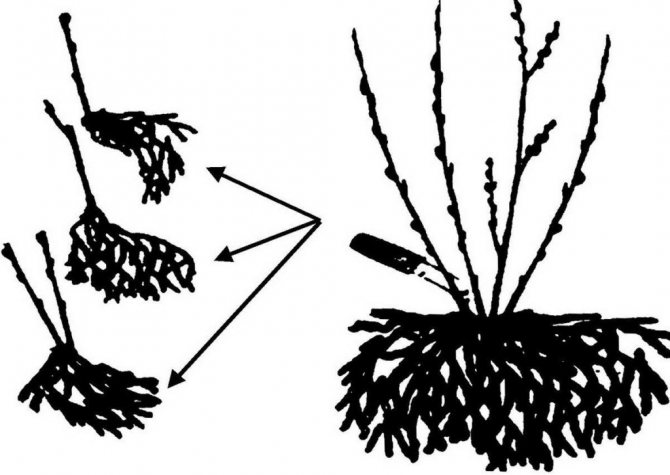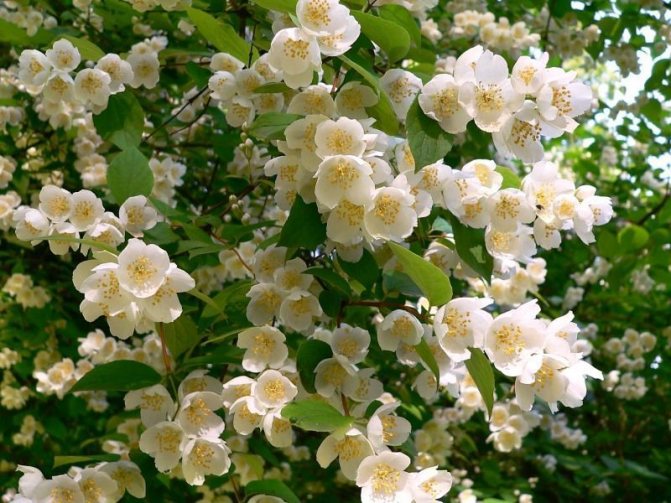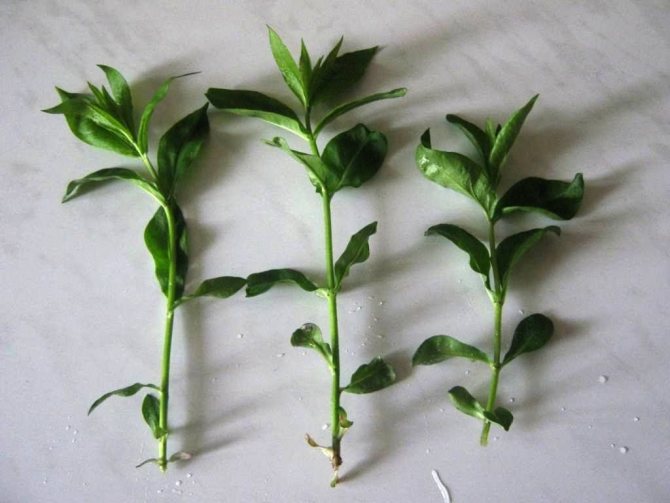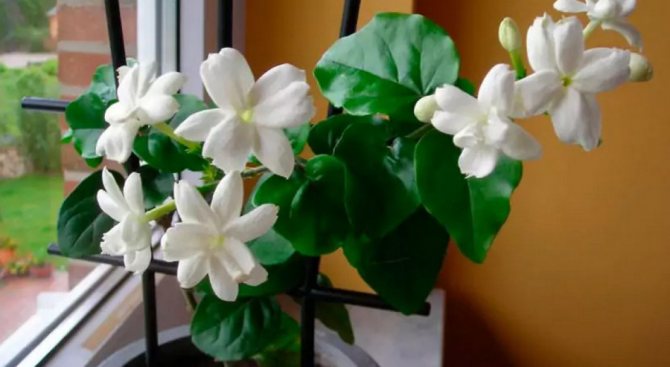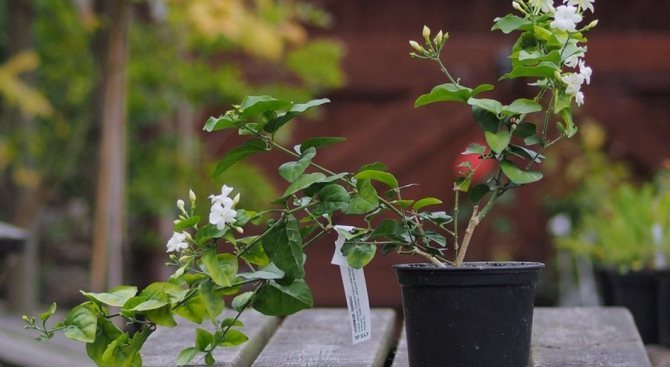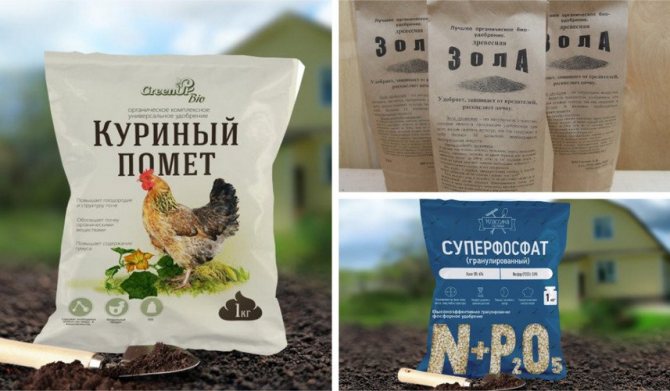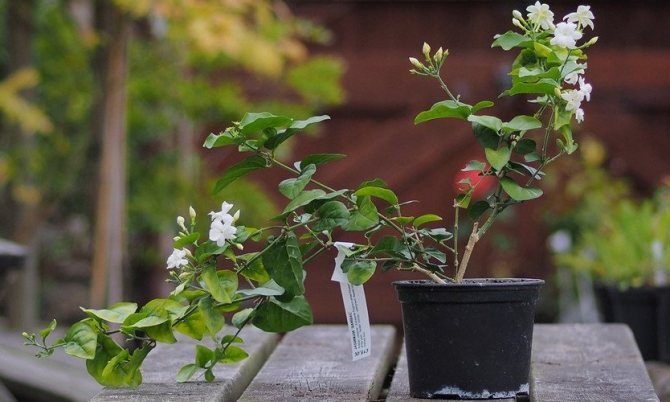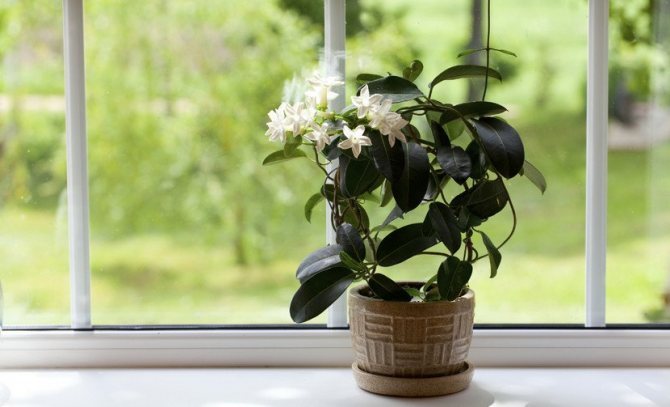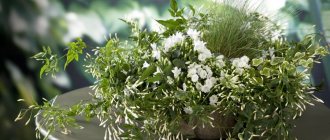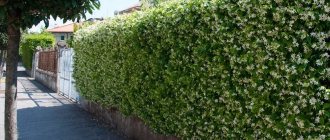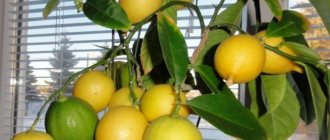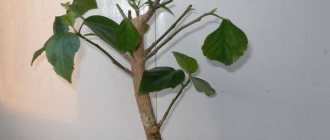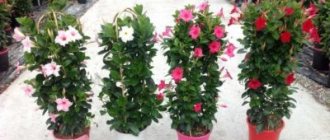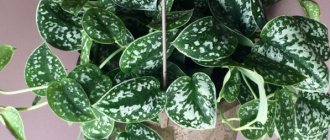We today almost invariably associate the name of jasmine with the popular and fairly common garden shrub chubushnik. But in fact, this plant has nothing to do with the representatives of the legendary fragrant jasmine. And a similar scent should not be misleading. Jasmines are inimitably beautiful indoor lianas, evergreen, elegant, abundantly blooming, captivating with their simple nobility and fragrant flowers. Being a plant surprisingly graceful, real jasmine cannot boast of great endurance and even more frost resistance, and we grow it exclusively as a greenhouse or indoor plant. But on the other hand, jasmines always become a real pride in the collection. To admire them, you need to provide plants with not so easy care. And the selection of growing conditions for this exotic handsome man does not diminish the hassle.
Jasmine species
Large-flowered jasmine (medicinal). The most unpretentious of all jasmine. It grows in almost any home environment. It can reach a height of 10 meters if not trimmed in time. It has large flowers in the form of white stars. The leaves are small. In the south of the country, in the Caucasus, it is grown outdoors for industrial use.
- Jasmine is multiflorous. This is a real vine that wraps around any support. It blooms with small white flowers that look like stars. Requires regular pruning of shoots to avoid exposing branches.
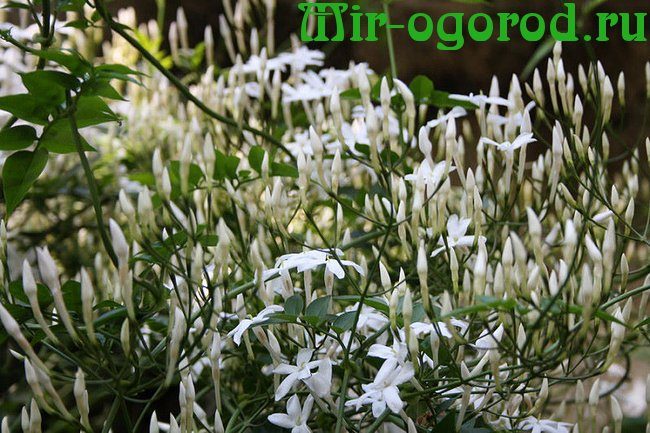
- Holoflower jasmine. Shrub plant with penetrating shoots. In winter, after the foliage falls, the flowering period begins, the flowers are bright yellow in color, located in the axils of the leaves.
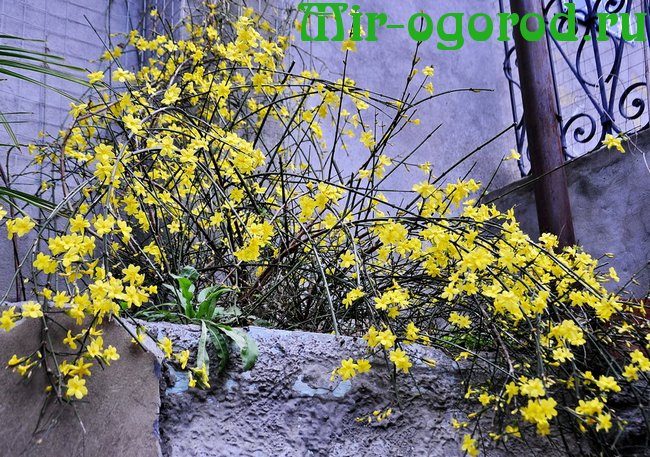

- Jasmine sambac (Arabic or Indian). It has long shoots. A very flexible plant. To give this variety of jasmine the appearance of a shrub, it is often necessary to prune it. The flowers are white, double, very fragrant. When blooming, they take on a pink color. In southern countries, it is grown for industrial use. The flowers of this particular variety of jasmine are used to make the famous Chinese jasmine green teas. It has been cultivated since 1665.
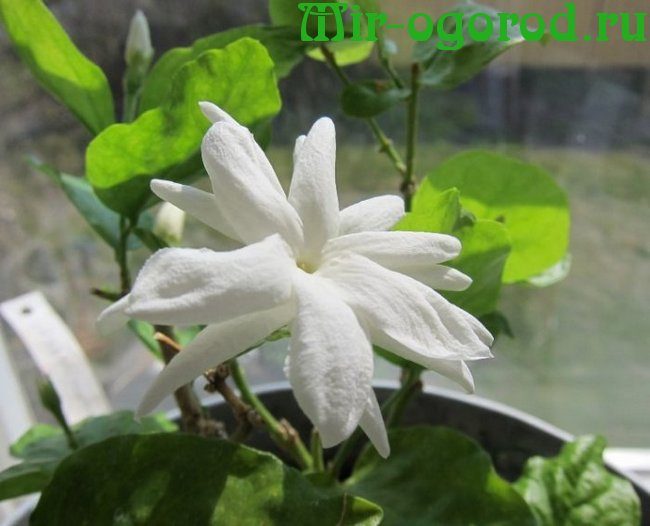

Features of the terry chubushnik
Terry chubushnik differs from other types of garden jasmine in that most of its varieties practically do not smell, but at the same time it looks very gorgeous, just look at the pictures and there will be a desire to decorate the garden with it, and therefore the question does not even arise - why it has become very popular with gardeners ... Other flowers, for example, a rose, which has a red or purple color, can be located very beautifully next to the mock-orange.


The most popular varieties of terry chubushnik:
- Snowstorm is a low, early flowering shrub with abundant white flowers, similar to snowflakes, hedges are possible from such shrubs.
- Ballet of moths - flowers have a non-standard shape in the form of moth wings.
- Zoya Kosmodemyanskaya is a very frost-resistant type of jasmine, with racemose inflorescences of double white flowers.
- Girandole, Blid or Brit is a shrub with a dense crown and vertically growing branches, profusely blooming with milky flowers.
Such varieties are no less popular. Shneesturm - has arcuate branches and large double flowers up to 5 cm in diameter. The ballet of moths is a bush with interesting flowers, shaped like moths.Minnesota snowflake - differs in very large and fluffy flowers, during flowering, the crowns literally bend under the weight of the flowers, a very lush bouquet is obtained from such flowers. Mermaid or Princess is a fast-growing mock orange with a dense crown and lush flowering. Snowbelle or Snow Beauty - has a pleasant subtle scent, blooms profusely in May-July, with large flowers.
Reproduction of indoor jasmine flower by cuttings
You can buy an adult jasmine bush in the store, but if there is already one plant in the house, then you can propagate it yourself.
The most effective propagation of indoor decorative jasmine flower in two ways:
- Cuttings.
- Layers.
Of course, jasmine can be propagated by seeds, but there is a risk that the varietal qualities of the plant will be lost. This method is applicable only for the propagation of wild plants.
Cutting is the most productive way, but at the same time it is laborious and requires certain skills. Propagate jasmine by cuttings, best in spring. They take root in room temperature water and root well in sand. It is best to take annual cuttings: after annual pruning, there will be a lot of them.
You need to follow these steps:
- Choose a mature, strong shoot.
- Cut off its top with two buds (10-15 cm).
- The cut must be done at an acute angle.
- Treat the cut with a biostimulator "Kornevin".
- Plant the cuttings in wet sand.
- Cover with foil.
- Moisten the soil daily.
After about a month, when the roots appear, the plants need to be planted in separate plastic cups and placed in a bright place. Without the use of a stimulant, the rooting process can take longer, up to 2 months.
If there are no rooting phytohormones in the florist's arsenal, then honey can be used to propagate the ornamental jasmine shrub. Dissolve one teaspoon of honey in water and keep the cuttings in it for a day, and then place them in the sand.
The substrate must be moistened daily so that the roots do not dry out. The use of transparent cups is very convenient in order to observe the development of the root system. When the whole space is braided with roots, you can transplant the flower into a larger pot (about 10 cm in diameter). Another indicator of successful rooting of the cuttings is the appearance of new leaves.
Plant propagation
Jasmine can be propagated in several ways:
- Seeds. They can be sown directly into open ground or grown into seedlings.
- By cuttings. They need to be prepared in early June. Then the cuttings are planted in the greenhouse, but you can immediately in the open ground.
- Shoots. In the spring, you need to separate the stronger shoots with roots from the main bush. Plant them in a greenhouse, and after a successful transfer of the winter period, plant them in a permanent place.
- By dividing the rhizome. This method is rarely used, it is too laborious and does not always bring a positive result. The procedure is carried out in the fall.
Jasmine propagation by cuttings in the fall is carried out with especially valuable varieties or blooming double buds.
It is necessary to cut the cuttings of lignified shoots in the fall and dig in on the site. Can be placed in a box of sand until spring and stored at zero temperature. And in the spring, plant on the site.
Propagation by cuttings of jasmine. Video:
Lighting for growing indoor jasmine
The houseplant jasmine loves the sun, but not direct sunlight. Because of them, the leaves can get burned, so when the flower is on the sunny side, it must be shaded (put a screen, hang tulle or film). If the sun is not enough, then the jasmine grows slowly and does not bloom. It is necessary to accustom him to light gradually: first put in partial shade, and then in diffused sunlight. In summer, homemade jasmine can be exposed outdoors.
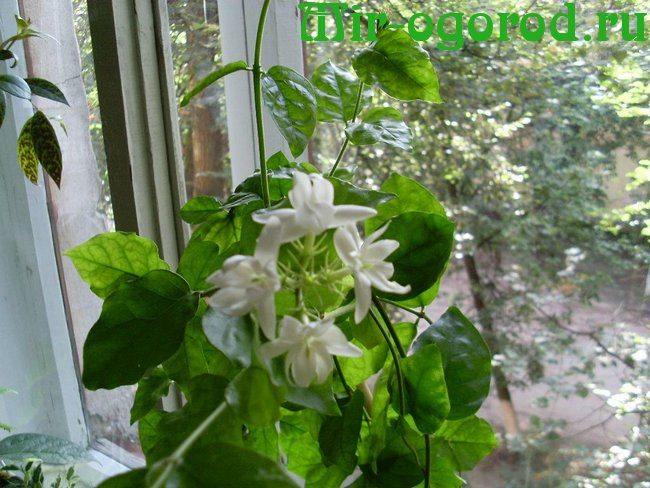

Homemade jasmine and its varieties
The genus of jasmine has over three hundred species that are common in the tropics and subtropics. A small part of them are used in indoor cultivation. Genuine or real jasmines are members of the Olive family. Height varies greatly depending on the species - it can range from 1–2 to 5–10 m. Description of the plant:
- All species, without exception, are evergreen shrubs, which are among the climbing vines.
- Shoots clinging, surprisingly flexible, thin. They need to be supported so that a beautiful and dense bush forms.
- Drooping branches develop actively, quickly braid and hide support. Thanks to this, the plant, when formed, becomes a lush dense bush.
- The leaves are whole-edge with an ideal oblong-oval shape and a pointed tip. They sit in pairs on short stalks and form a spectacular classic green crown.
- The flowers of the plant are simple, noble at the same time. They are simple, tubular, or terry. They have wide open and deeply dissected corollas, divided into 6 petals. A cylindrical tube is almost invisible under them.
- The axillary flowers of the vine are collected in the inflorescence scutes, which are located in the leaf axils. Shimmering whites and creams are classic color shades. Despite the fact that they have become the symbol of all jasmines, the color palette also includes pink, yellow variations.
Multi-flowered
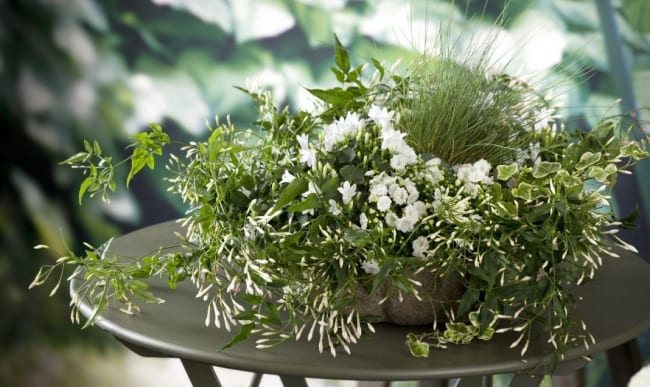

Jasmine multiflorous
When deciding to grow jasmine at home, pay attention to the multi-flowered species (Jasminum polyanthum). It differs from other species by its strong branching. It reaches a height of 1.5–2 m. Detailed description:
- Leaves are oval with a pointed and slightly wavy edge, arranged alternately. They are dark green in color.
- Flowers are tubular, numerous. Their limb is divided into 5 lobes, collected in loose apical inflorescences. The pink buds turn white when blooming.
- The multi-flowered shrub is popular for its stronger aroma than other species. This species blooms from February to August.
- The flowers reach 2.5 cm in diameter. They bloom in January-March.
Today this species includes the finest jasmine (Jasminum gracillimum), which previously stood out as an independent species. It does not differ much from the basic form - it is a compact liana with thin, drooping shoots, strong leaves (up to 3.5 cm) and a heart-shaped base. The main difference lies in the flowers. In this climbing shrub, the flowers are collected by the umbrellas of the inflorescences, the corolla of which is divided into 8 lanceolate petals.
Large-flowered
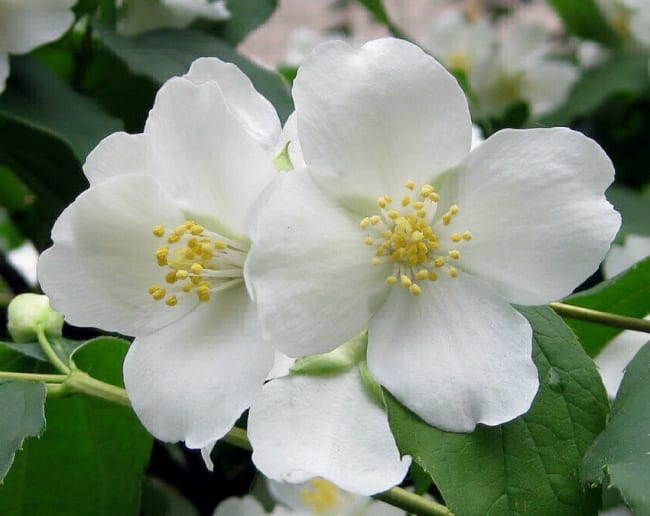

Jasmine large-flowered
This type of jasmine (Jasminum grandiflorum) is a majestic vine up to 10 m high with absolutely bare shoots. Main characteristics:
- The leaves are pinnate, opposite. They differ from other leaves by their dark color and elliptical shape with a pointed apex.
- Flowers are collected at the tops of the shoots with up to 10 umbrellas. They begin to appear in large numbers evenly from June to October.
- The fold is divided into 5 petals. The flowers themselves are snow-white, fragrant.
Jasmine Bissa
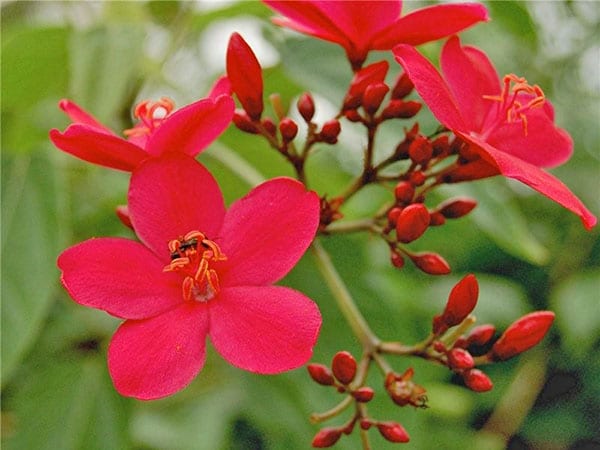

Jasmine Bissa
This is an evergreen shrub vine (Jasminum beesianum), which has shoots up to 2 m long. They are covered with longitudinal grooves. Flowering occurs in May. It is shorter than other species. Description of this species:
- Leaves are lanceolate and simple, opposite. They reach 5 cm in length. They are distinguished by an almost imperceptible edge. The color of the leaves is dark green, brighter than that of other species.
- The flowers are very fragrant, deep pink or pink. They bloom at the tops of the shoots and gather in whorls up to 3 pieces. They reach 2 cm in diameter.
Holoflower
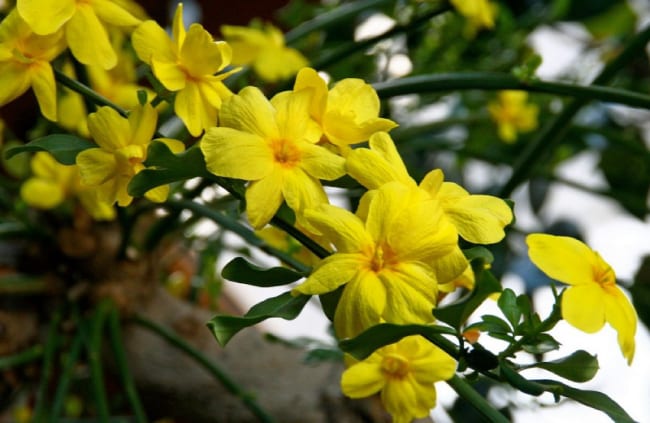

Holoflower jasmine
This type of indoor climbing shrub (Jasminum nudiflorum) differs from others in the more rare foliage of graceful shoots and weak branching. It has the nickname "winter jasmine". Specific traits:
- The leaves of this indoor shrub are small and painted in a bright green hue. For the winter, they fall or remain in small quantities.
- The flowers are dazzling yellow. They are large - more than 3 cm.
- Flowers bloom in the axils of the leaves one at a time, but they appear along the entire length of the stem from January to April.
Jasmine Sambac
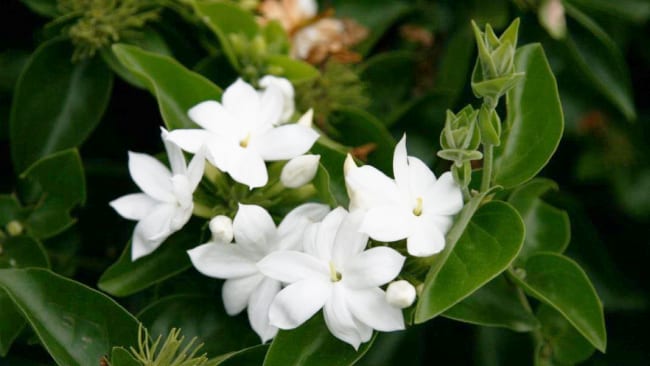

Jasmine Sambac
It is the easiest to grow and the most unpretentious type of jasmine (Jasminum sambac), which is suitable for a warm winter. The shoots of this plant in nature can reach 6 m in length. Description of the species:
- Shoots are pubescent and woody in comparison with other species.
- Leaves are ovoid and opposite. In length they reach 10 cm. Sometimes they are assembled in whorls of 3 pieces.
- The rounded base of the leaves is almost invisible. The top can be either blunt or pointed. The finish ranges from lightly lowered to glossy.
- The flowers are very fragrant, large, double or semi-double. Collected in a brush of 3-5 inflorescences. Are exceptionally white
- Sambac flowering is unusually long. Falls from March to October.
- Terry flowers in appearance resemble semi-double roses or camellias than other indoor vines.
Watering indoor jasmine
Watering is required in moderation. You can water more often during the warmer months. You can control the plant's need for liquid by checking the condition of the soil. If the air temperature is high enough, watering should be done more frequently and the top of the plant should be sprayed. In the cold season, spraying can be omitted.
In order for the plant to have strong shoots, succulent leaves and please with a large number of flowers, it is important not to forget about systematic feeding. Such care for a indoor jasmine flower should be carried out no more than twice a month. An excess of nitrogen fertilization enhances the growth of shoots, which negatively affects the flowering of the plant.
Strawberry mock-mushroom varieties
Strawberry chubushnik is the most fragrant of the species of this plant, and only small-leaved jasmine has a smell similar to strawberries. Strawberry chubushnik is usually a short bush up to 1.5 meters, lushly blooming and with small pointed leaves.
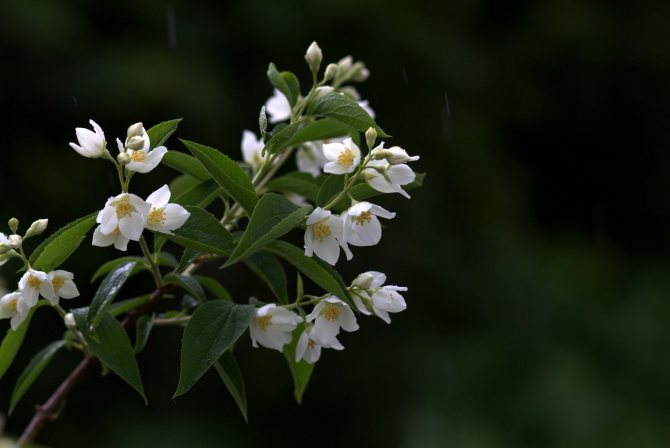

The names of varieties of strawberry chubushnik and their differences:
- Mont Blanc or Mont Blanc - flowers are semi-double varieties, up to 3.5 cm in diameter.
- Airborne assault - has long shoots and a very strong aroma
- The ermine mantle or Yasmina is distinguished by a long flowering period and a pleasant strawberry smell, and its flowers resemble the tails of an ermine.
- Snow avalanche - many colors resemble an avalanche descending from the mountains
- Chamomile is a completely different variety. It looks like a chamomile with white long pointed petals.
- Aurea or Aureus is an ornamental shrub with small flowers, its leaves have an unusual golden color.
Garden jasmine is a very beautiful plant. It will not be difficult to grow it in your garden or in the country, the chubushnik is not afraid of frost and is unpretentious in care.
A variety of varieties will allow you to use shrub jasmine in any landscape design and please even the most demanding florist. And indoor jasmine will adorn any apartment and fill it with a delicate delicate aroma.
Pruning indoor jasmine
Regular pruning helps the jasmine to be a lush and beautiful plant. Pruning not only improves the appearance of the plant, but also stimulates flowering. The vine tolerates this procedure very well, it will not bring harm. The best time for pruning is before growth begins, in late February or March. Healthy shoots are shortened by a third, diseased lashes - by half.Young plants need to pinch the top so that they grow and develop better. Adult specimens are pinched selectively, during the period of active growth.
Home care
The main rule is the timeliness of agrotechnical measures. Growing Jasmine is easy, you just need to know some of the nuances. If the grower does not follow the rules specified in the following sections, then even such an unpretentious plant as Jasmine will grow poorly, and the buds will be medium-sized and in smaller quantities.
Location and choice of flowerpot
Thick shade, dampness, lack of light are factors that interfere with active vegetation and abundant flowering. A pot with a lush bush is placed on a stand near the window so that the sun illuminates the plant well. In the absence of heat, it is permissible for direct rays to fall on the leaves, but shading with blinds will be needed in July-early August. It is important to find a balance so that the room is not too dark.
Where to place the plant? A prerequisite is in an area where there are no drafts. Airing is carried out by opening the window, with the doors closed: this way it is easier to exclude the influence of negative factors. Without fresh air, the plant does not develop well, but gusts of wind and drafts are not needed.
The correct flowerpot:
- the intensity of root growth is medium, a flower pot of moderate depth and width is needed;
- when choosing a new container during transplantation, the size of the bush and the diameter of the previous flowerpot are taken into account;
- the new flowerpot should be, on average, 3 cm larger than the previous one;
- for growing a moisture-loving plant, a flower pot made of unbaked clay, plastic is used, but metal buckets are not suitable;
- it is important that there are several drainage holes in the flowerpot: watering is frequent enough, abundant, moisture stagnation is not needed.
Soil and drainage
Key recommendations:
- In the flower shop, you can buy a suitable substrate for plants from the Olive family.
- It is important that the acidity level of the soil is between 6 and 6.5.
When preparing the soil mixture yourself, you need to take into account the difference in the proportions of the components:
- for an adult plant - leafy, clay-soddy soil and sand are mixed in equal proportions;
- for young Jasmine - clay-sod land is taken twice as much as other components.
Planting and transplanting
Important rules:
- after purchasing a new copy for green decor, it is advisable to move the flower to a new container and replace the substrate;
- the transplant is carried out not immediately after the "settlement" in the house of Jasmine Room, but after a couple of weeks, so that the plant acclimatizes in another room. During this period, the flower is kept in quarantine, separately from other plants. A simple technique prevents the relocation of pests and the transfer of diseases that may have entered the house with a new specimen;
- up to the age of four, the transplant is carried out annually, later - no more than once every two to three years;
- the movement is carried out with the preservation of the earthen coma. It is important to check the condition of the underground part, remove the rotten areas of the roots, treat the remaining areas with fungicides (preparations from the fungus);
- the optimal period for transplantation is the beginning of March. After moving the evergreen bush to a new container, the diameter of which is 3 cm larger than the previous one, the flower is not disturbed for about a week. During this period, feeding is not needed, watering is carried out immediately after transplanting and is resumed only after 7-8 days.
Visual video - instructions for transplanting Jasmine room:
Content temperature and humidity
A positive nuance when growing indoor jasmine - the plant tolerates moderate heat well, there is no need to create "tropics" at home. Optimum performance is from +20 to + 22 ° С. In winter, the temperature is slightly lowered so that the flower can rest, gain strength for the growth of young shoots in spring.
A plant with rich green leaves loves moisture: in a hot season, spraying is carried out to avoid yellowing of the elements. If the air in the room is dry, then the liquid from the spray bottle is sprayed every day. The higher the room temperature and the lower the humidity, the more actively spraying is performed.
A warning! Very dry air combined with poor soil moisture are factors that negatively affect the condition of many plants, including indoor jasmine. Another reason why excessive dryness of the environment and soil should not be allowed is the active reproduction of spider mites: tiny parasites that are very difficult to get rid of. Pests do not like moisture, and only the normalization of the regime of adding liquid to the soil and spraying prevents re-colonization of mites.
Watering and spraying
In the previous section, the consequences of poor substrate moisture are indicated: Indoor jasmine not only grows poorly, but conditions are also created for the settlement of dangerous pests of indoor plants - spider mites.
On a note:
- The moisture-loving species needs regular watering, the frequency depends on the temperature in the room and the rate of drying of the top layer of the soil. The warmer it is in the home, the more often the bush is watered.
- You cannot fill the plant: stagnant moisture is the main cause of root rot, which is difficult to combat.
- Watering is carried out only with settled water, of course, at room temperature: even in the heat, you cannot use cold liquid.
- To enhance the growth of a beautifully flowering species, increase vitality, and develop resistance to diseases, a natural remedy is used - succinic acid.
- If pests settled on Indoor jasmine and had to use powerful insecticides (for example, Actellik), then a safe growth stimulant and "resuscitator" - the drug Fitosporin - is suitable for restoring strength.
Indoor jasmine is sprayed in summer, when the humidity of the air decreases and the temperature rises. Without carrying out a simple procedure, the foliage withers, dries up, decorativeness decreases. In a young bush, you can gently wipe the leaves with a damp cloth, but spraying is easier, and there is no excess pressure on delicate greens.
Lighting and supplementary lighting
Indoor jasmine grows well in a bright room. It is important that your home or office has enough light throughout the day. Despite the benefits of sunlight in spring and autumn, you need to be careful with ultraviolet in the summer. On a hot afternoon, a bush with a lush crown is shaded to avoid burns and yellowing of the leaves.
In winter, the plant should rest; additional lighting is not required during the dormant period. You should not keep a light-loving plant in the northern room, especially if tall trees grow next to the house, which significantly limit the access of light.
Top dressing and fertilizers
Active fertilization (every 10-14 days) is carried out in the season of increased growth, from spring to August. Use mineral formulations for beautifully flowering houseplants, preferably in liquid form. It is important that there is enough potassium in the mixtures: the chances of abundant flowering increase.
Fertilizers are applied to wet soil, a short time after watering. You need to be careful with granular products: exceeding the dosage can lead to root burns.
Flowering and resting period
Indoor jasmine blooms in early summer, delicate buds are pleasing to the eye in autumn. A rich, sweetish aroma spreads throughout the room. It's important to know: in a small room or bedroom, a beautifully flowering plant with a rich smell is not placed in order to prevent headaches in households and the hostess.
If in summer it is very hot and stuffy, then it is imperative to water and spray the bush more often, otherwise the buds fall off, the flowering is not so abundant. Also during this period, good lighting is required, but at noon, you need to shade the decorative look.Timely feeding with liquid mineral fertilizers with a high potassium content has a positive effect on the duration of flowering.
It is advisable to immediately remove wilted buds from the bush so that the plant does not waste juices and energy in vain. It is bad if the petals accumulate on the surface of the substrate, rot, a favorable environment is created for the development of fungi and various kinds of diseases.
On a note! Jasmine does not have a pronounced rest period, but at the end of autumn, you need to arrange a small rest for the beautifully blooming species. The pot with a bush is transferred to a cool room (all faded buds are first removed), less often watered, almost not fertilized. Be sure to adjust watering taking into account temperature fluctuations, make sure that the soil does not dry out.
Pruning
For the splendor of the Jasmine Room bush, crown formation is carried out annually. At the end of February or in the first decade of March, the shoots are shortened: healthy, strong ones - they remove half the length, weak, thin ones - they are reduced by one third. If a lot of young twigs have formed on the plant, then the elements are pinched.
Jasmine in the office and home, with good care, grows up to 1 m or more. Under the weight of the leaves and against the background of the long length of the shoots, the plant loses its decorative effect, the stems diverge to the sides, lean towards the ground. For good growth and preservation of health, Jasmine creates a support in the form of an elegant plastic structure or a metal product that does not rust. It is convenient to use a semicircle on which branches are placed. To prevent the stems from dropping too far, it is helpful to wrap them with rope or decorative tape.
Indoor jasmine pests
Before starting to clean the flower, carefully inspect all the plant sprouts. If the damage has not spread to the entire indoor jasmine flower, remove the pests with a soapy solution. Otherwise, it is recommended to use decoctions or infusions.
- Recipe 1. 1 kg of potato tops, pre-dried, pour 5 liters of water. Insist for 10 hours. Filter. Apply as spraying 3 times every 5 days.
- Recipe 2. Chop 600 g of green mustard and pour 10 liters of water. Filter after 48 hours. Apply as a spray against weevils and aphids.
- Recipe 3. Insist 1 kg of burdock leaves in 10 liters of water for 48 hours. Filter out. Spray three times, at intervals of five days.
- Recipe 4. 800 grams of dry crushed yarrow pour 3 liters of water. Boil for half an hour, add another 7 liters of water. Filter. The spraying interval is the same as in the previous versions. Used against spider mites and aphids.
- Gardener's calendar for 23 June 2018
- Room gardenia care: basic requirements and nuances
Category: Cottage
Diseases and pests, control methods
Indoor jasmine is a flower resistant to various diseases if the plant is strong and kept in a suitable microclimate. Sometimes the roots rot, which is associated with excessive watering or improper arrangement of the drainage layer. To destroy the fungus, chemical and biological agents are used - fungicides.
Spider mites, scale insects and aphids are pests that enter the plant while still in the flower shop or penetrate through open windows.
What to wish for when identifying them? Proven methods:
- To kill ticks, acaricides are used (Anti-tick, Fufanon, Neoron, Aktellik), they necessarily normalize air humidity and watering: parasites love the dryness of the substrate and environment.
- To combat scale insects and aphids, a soap solution is used, after which the insects suffocate. To consolidate the result, insecticides are used: Confidor Maxi, Aktara, Fitoverm.
All work with any chemicals and biological products is performed in medical gloves, a respirator, closed clothing, with a hat, in the fresh air, in calm weather. If the bush is very large, and it is inconvenient to take the flowerpot out into the yard, then you can put the plant on the balcony, spray the soil, stems and leaves. It is important to adhere to the requirements of the instructions: re-processing of the bush is often necessary.
Landing
Seedlings of "terry jasmine" are planted in early spring or autumn. When planting, the holes are dug at a distance of 50–150 cm. If you plan to create a green fence from the chubushnik bushes, then the cuttings should be planted at a distance of 50–80 cm.
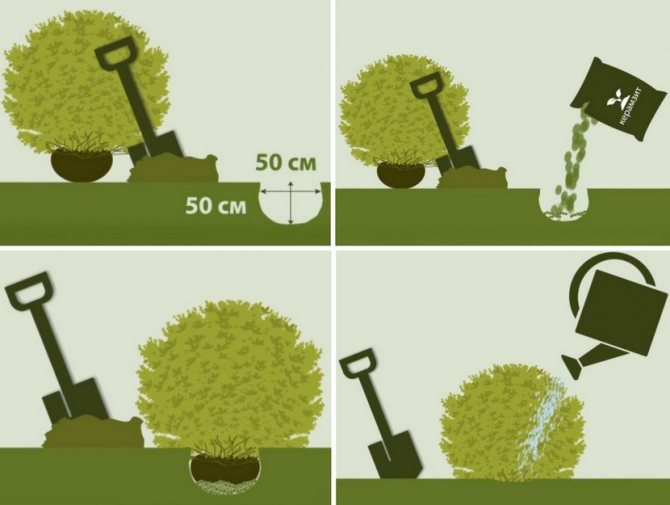

Seat selection
The area for the chubushnik is chosen well-lit, where there is a lot of sunlight, then it grows more magnificently and blooms longer. The plant prefers drained soil and does not tolerate stagnant moisture in the soil, so it should be planted where there is no groundwater close to the surface. The best place for planting is a small hillock.
Read more about when and how to plant jasmine.
Soil preparation
"Terry jasmine" plant is unpretentious, but it loves soils more, where there is black soil, humus and river sand. Therefore, before planting the shrubs, the soil must be prepared by digging a hole about 50 cm deep and wide a few days before planting, and pouring drainage from rubble and sand into it 15-20 cm thick. Then the hole is heated in the sun for several days and the seedlings are planted, sprinkling them with pre-prepared soil. It is prepared from humus, wood ash and black soil in a ratio of 1: 1: 1 (1 kg of wood ash and black soil per bucket of humus).
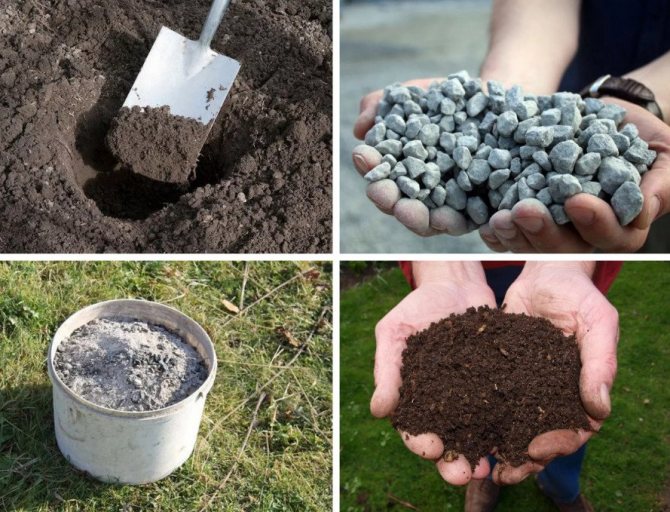

Chubushnik: description and characteristics
In nature, there are more than 70 species of mock-orange from the Hortensian family (Philadelphus Hydrangeaceae) or garden jasmine. The shoots are distinguished by wood on the outside and a soft core on the inside. The plant was named among the people due to the fact that stems and mouthpieces for smoking pipes were made from the shoots. The plant can be undersized, spreading or in the form of a liana, reaching 3.5-4 m.
On the thin stems of the shrub, there is a gray or brown bark, small leaves grow. Chubushnik loves sunny places, but withstands the shade, can feel good on wet soils, tolerates the proximity of groundwater, but does not tolerate stagnant water. The bushes are smoke resistant and can tolerate temporary drought.
Buds with petals of different colors appear at the end of May and last until the beginning of August. They may be odorless or exude a subtle, subtle scent.
Choice of place and conditions of detention
Jasmine is a shrub up to 4-6m tall, with straight long branches and inflorescences of fragrant flowers that bloom at night. In the morning they fall off, and new inflorescences bloom, flowering continues for several weeks. Each inflorescence consists of 5-6 flowers, they can be white, yellow and pink (see photo).
Jasmine has a fairly high resistance to unfavorable environmental factors, but for a spectacular and full-fledged flowering, certain conditions are necessary.
- The right place to grow;
- Completeness of lighting and presence of shadows;
- Humidity, dry wind protection;
- Temperature regime;
- Protection from winds and drafts;
- Soil composition.





